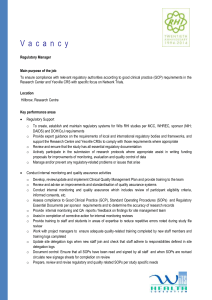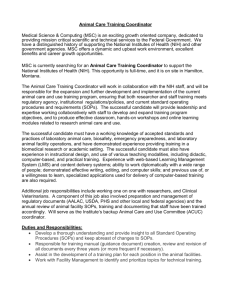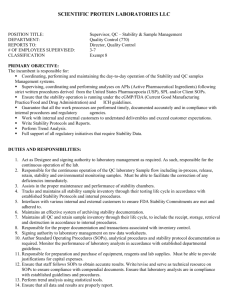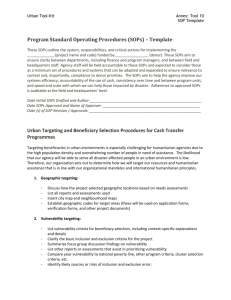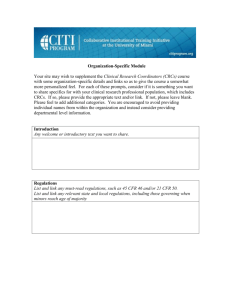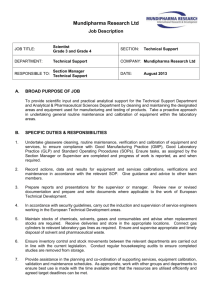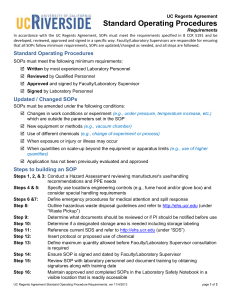Supplementary Data
advertisement
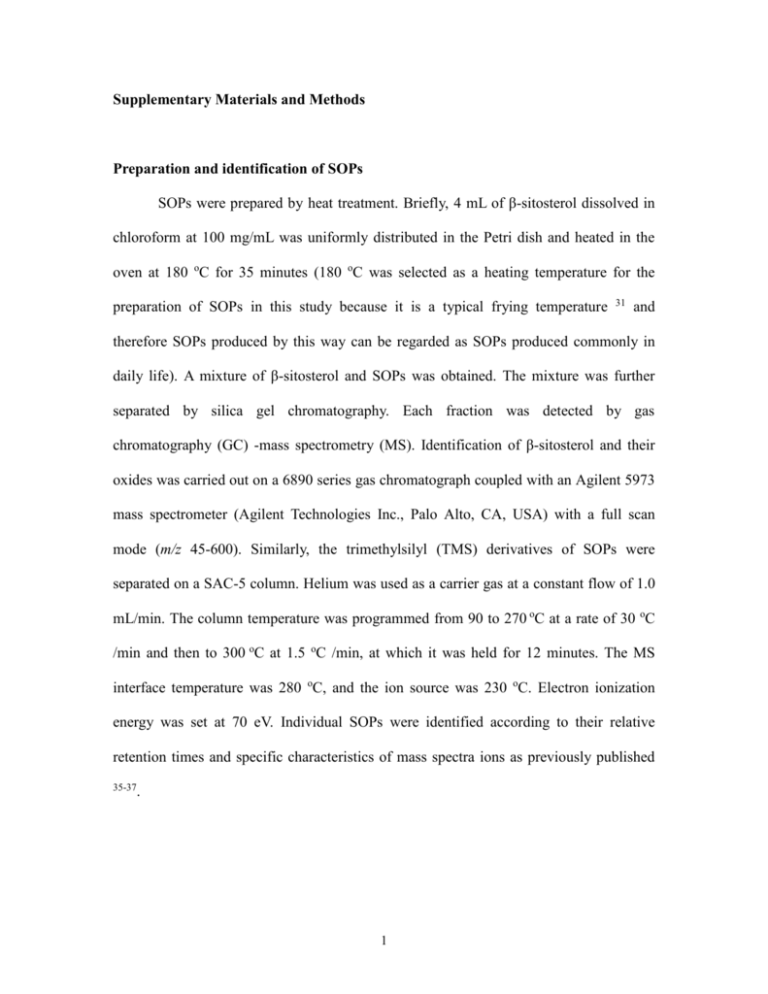
Supplementary Materials and Methods Preparation and identification of SOPs SOPs were prepared by heat treatment. Briefly, 4 mL of β-sitosterol dissolved in chloroform at 100 mg/mL was uniformly distributed in the Petri dish and heated in the oven at 180 oC for 35 minutes (180 oC was selected as a heating temperature for the preparation of SOPs in this study because it is a typical frying temperature 31 and therefore SOPs produced by this way can be regarded as SOPs produced commonly in daily life). A mixture of β-sitosterol and SOPs was obtained. The mixture was further separated by silica gel chromatography. Each fraction was detected by gas chromatography (GC) -mass spectrometry (MS). Identification of β-sitosterol and their oxides was carried out on a 6890 series gas chromatograph coupled with an Agilent 5973 mass spectrometer (Agilent Technologies Inc., Palo Alto, CA, USA) with a full scan mode (m/z 45-600). Similarly, the trimethylsilyl (TMS) derivatives of SOPs were separated on a SAC-5 column. Helium was used as a carrier gas at a constant flow of 1.0 mL/min. The column temperature was programmed from 90 to 270 oC at a rate of 30 oC /min and then to 300 oC at 1.5 oC /min, at which it was held for 12 minutes. The MS interface temperature was 280 oC, and the ion source was 230 oC. Electron ionization energy was set at 70 eV. Individual SOPs were identified according to their relative retention times and specific characteristics of mass spectra ions as previously published 35-37 . 1 GC-MS identification and the components of SOPs SOPs standards are not commercially available, so the analytical methods for SOPs have been carried out using commercial COPs as model substances, assuming that the ionization efficiency of both types of molecules and their behavior are very similar due to their structural similarity. Previous studies showed that response factors obtained for COPs are also valid for quantitative work regarding phytosterol oxidation products (POPs) 19,31,73. SOPs were identified by both relative retention times and mass spectra data of TMS ethers derivates of SOPs as demonstrated in Supplementary Table 1. The characteristic ions in bolds indicate those used for the qualitative analysis in the selected ion monitoring (SIM) spectra. The ions identified for each SOPs were compared with COPs standards and also previously published spectra 19,73 . Relative retention times in relation to 5α-cholestane are also shown in Supplementary Table 1. Aortic ring preparation The thoracic aorta was dissected out, removed of adhering connective tissues, and cut into ring segments of around 3mm-wide. Each ring was suspended between two stainless wire hooks in a 10 mL organ chamber filled with Krebs solution containing (in mM): 119 NaCl, 4.7 KCl, 25 NaHCO3, 2.5 CaCl2, 1 MgCl2, 1.2 KH2PO4, and 11 Dglucose. The upper wire was connected to a force–displacement transducer (Grass Technologies, West Warwick, RI, USA) and the lower one was fixed to the bottom of the organ bath. The bathing solution was oxygenated by 95% O2 and 5% CO2 and maintained at 37 oC (pH 7.4). Rings were allowed to equilibrate for 30 minutes before being adjusted 2 to an optimal resting tension of 25 mN. In some rings, the endothelial layer was mechanically disrupted by very gently rubbing the luminal surface of the artery with forceps. Western blotting Isolated aortae were incubated with SOPs (30 μg/ml) or solvent for 60 minutes. Some rings were pre-treated with tempol (30 µM) before exposure to SOPs. In some experiments, primary endothelial cells were used. After treatment, rings or cells were frozen in liquid nitrogen and stored at -80 oC for later processing. The rings were homogenized with ice-cold RIPA lysis buffer (PBS containing 1% NP-40, 0.5% sodium deoxycholate, 1% SDS) supplemented with 1% protease inhibitor cocktail [leupeptin (1 µg/mL), aprotinin (5 µg/mL), PMSF (100 µg/mL), sodium orthovanadate (100 µg/mL), EGTA (200 µg/mL) and EDTA (200 µg/mL)] and phosphatase inhibitor cocktail [NaF (250 mM), β-glycerolphosphate (500 µg/mL) and HEPES (50 mM, pH 7.3)]. The lysates was then centrifuged at 16,000 g, 4 oC for 20 minutes. Supernatant was collected and protein concentration was determined by Bradford Assay (Bio-Rad Laboratories, Hercules, CA, USA). One volume of 2x gel loading buffer containing 10% βmercaptoethanol was added and the samples were denatured by boiling for 10 minutes. Equal amounts of total protein were separated under reducing conditions on a 7.5% SDSpolyacrylamide gel. Pre-stained Novex Sharp Standard marker (Invitrogen, Grand Island, NY, USA) was loaded in parallel as a standard molecular weight marker. The resolved proteins were electroblotted to immobilon-P polyvinylidene difluoride (PVDF) membrane (Millipore, Billerica, MA, USA) using wet transfer at 110 V for 80 minutes at 3 4oC. The membranes were blocked with 5% non-fat milk for 1 hour at room temperature. Blots were incubated with primary antibody against COX-1 (mouse monoclonal, 1:500) (Cayman, Ann Arbor, MI, USA) or COX-2 (rabbit polyclonal, 1:300) (Cayman) overnight at 4 °C in 5% non-fat milk. Glyceraldehyde-3-phosphate dehydrogenase (GAPDH, 1:10000) (Ambion, Invitrogen) was used as a housekeeping protein. After washing with TBST, blots were incubated with horseradish peroxidase-conjugated secondary antibodies (rabbit anti-mouse and goat anti-rabbit antibodies, Dako, Glostrup, Denmark) at a dilution of 1:5000 in 5% non-fat milk for 1 hour at room temperature. The membranes were developed with an enhanced chemiluminescence detection system (Western lighting plus-ECL; PerkinElmer, Waltham, MA, USA) and then exposed to Xray films (Fuji, Tokyo, Japan). The signal intensities were quantified using AlphaEase software of the FluorChemTM 8000 digital gel documentation system (Alpha Innotech Corp., Santa Clara, CA, USA). For each experimental group, signal intensity of the target protein will first be normalized to that of the housekeeping protein GAPDH. The value obtained from treatment group will then be normalized to that of the control group. Immunohistochemical staining Localization of COX-2 in the rat aorta and the effect of SOPs treatment on COX2 expression were determined by immunohistochemistry. The tissues were fixed overnight in 4% paraformaldehyde, processed for embedding in wax and cut into 5 μmsections. Following re-hydration and treatment with 1.4% hydrogen peroxide in absolute methanol for 30 minutes at room temperature to inhibit endogenous peroxidase activity, antigen retrieval was performed by boiling the sections in 0.01 mol/L sodium citrate 4 buffer (pH 6) for 30-60 seconds. After rinsing in PBS, the sections were blocked with 5% donkey serum and incubated overnight with COX-2 antibody (1:100) (Abcam, Cambridge, UK) or COX-1 antibody (1:100) (Cayman) diluted in PBS supplemented with 2% BSA in a humidified chamber at 4 oC. The sections were then incubated with biotinylated anti-rabbit secondary antibodies (1:200) (Dako) or anti-mouse secondary antibodies (1:200) (Dako) for 1 hour at room temperature, followed by 1-hour incubation with peroxidase-conjugated streptavidin. DAB (Vector Laboratories, Burlingame, CA, USA) was used for colour development according to the manufacturer’s instruction. Counter-staining of nuclei and cytoplasm was performed with haematoxylin and eosin, respectively. Negative control was performed in the absence of primary antibody. Images were viewed and captured under Leica DMRBE microscope coupled to SPOT-RT cooled CCD color digital camera using the objective PL FLUOTAR 20x/0.50 and SPOT Advanced software (Version 3.5.5). Primary culture of rat aortic endothelial cell Endothelial cells were cultured from rat thoracic aortae as described 38 . Briefly, the aorta was placed in ice-cold sterile PBS and trimmed of periadventitial adipose tissues. After cutting open longitudinally, the artery was subjected to digestion in 0.2% collagenase (Type IA; Sigma, St. Louis, MO, USA) for 15 minutes at 37 oC. The cell suspension was centrifuged at 800 g for 10 minutes and then re-suspended in cell culture medium which contained RPMI 1640 supplemented with 10% fetal bovine serum (FBS) and 1% penicillin/streptomycin (P/S) (Gibco, Invitrogen). Cells were changed with fresh medium containing the same components after settling for 1 hour. Identity of the 5 endothelial cells was previously validated by a positive staining of the endothelial cell specific marker, platelet/endothelial cell adhesion molecular-1 (PECAM-1). Measurement of reactive oxygen species (ROS) by dihydroethidium (DHE) Intracellular level of ROS in primary rat aortic endothelial cells was determined by DHE (Molecular Probes, Invitrogen) fluorescence emitted upon oxidation. Endothelial cells were seeded on coverslips to ~60-70% confluence and incubated with SOPs (30 μg/mL) for 10, 15, 30, 45 or 60 minutes for determination of the peak ROS level stimulated by SOPs. In another set of experiments, cells or transfected cells were preincubated with an ROS scavengers or NADPH oxidase inhibitor for 30 minutes before 15 minutes-incubation with SOPs. Cells were rinsed with normal physiological saline solution (NPSS in mM, 140 NaCl, 5 KCl, 1 CaCl2, 1 MgCl2, 10 glucose, 5 HEPES, pH 7.4) after the treatments and incubated in 5μM DHE for 20 minutes at 37 oC in dark. After a rinse in NPSS, fluorescence was observed under a confocal microscope (Olympus Fluoview) (Olympus, Tokyo, Japan) with 515-nm excitation and filtered through a 585nm long pass filter. DHE fluorescence intensity was analyzed by Fluoview software (version 1.5; FV10-ASW1.5) and the data were expressed in fold change compared with control treated with vehicle (final concentration of 0.1% ethanol). Measurement of ROS by electron paramagnetic resonance (EPR) spin trapping To determine intracellular ROS levels in primary rat aortic endothelial cells, electron paramagnetic resonance (EPR) was also performed with 1-hydroxy-2,2,6,6tetramethyl-4-oxo-piperidine hydrochloride (TEMPONE-H, 100 μM, Alexis Co., 6 Bingham, UK) as the spin trap for superoxide anions. A transition metal chelator diethylenetriaminepentaacetic acid (DTPA, 100 μmol/L, Sigma-Aldrich) was applied to inhibit reactions catalyzed by transition metals. After incubation, cells were collected in 100 μL NPSS solution and placed into glass micropipettes for signal detection. X-band EPR spectra were measured at room temperature using an EMX EPR spectrometer (Bruker BioSpin GmbH, Siberstreifen, Rheinstetten/Karlsruhe, Germany). The EPRsettings were as follows: Center field: 3476 G; Sweep width: 80 G; Microwave frequency: 9.712 GHz; Microwave power 2.5 mW; Modulation frequency: 100 kHz; Modulation amplitude: 0.4 G; Time constant: 2.56 msec; Conversion time: 20.97 sec. Interpretations of EPR spectra were done according to hyperfine EPR splitting constants reported by Dikalov et al. 74,75 and Janzen and Hare 76. Measurement of nitric oxide Intracellular level of nitric oxide in primary culture of rat aortic endothelial cells was determined by DAF-FM diacetate (Molecular Probes, Invitrogen) fluorescence emitted upon addition of ACh. Endothelial cells were seeded on coverslips to ~60-70% confluence; cells were pre-incubated with either vehicle or SOPs (30 μg/mL) for 60 minutes before loading dye. Cells were rinsed with NPSS once after the treatments and incubated in 1.5 μM DAF-FM diacetate for 20 minutes at room temperature in dark. After three rinses in NPSS, 10 μM ACh was added and the change in nitric oxide fluorescence was measured by a confocal scanning unit (FV1000, Olympus) with 488 nm excitation and an emission filter of 505-525 nm. Data were taken every 1 minute for 20 minutes. Changes in [nitric oxide]i were displayed as a ratio of fluorescence relative to the initial 7 intensity (F1/F0), and analyzed by the Fluoview software. Drugs Phenylephrine and indometacin were purchased from RBI (Natick, MA, USA). ACh, 9,11-Dideoxy-11α,9α-epoxymethanoprostaglandin F2α (U46619), tempol, tiron, diphenylene iodonium (DPI), SNP and oxypurinol were purchased from Sigma (St.Louis, MO, USA). Indometacin, A23187, SC-560, DuP-697 were purchased from Tocris (Bristol, UK). β-Sitosterol was purchased from Meihe Company (Shenzhen, China). S18886 was a kind gift from Institut de Recherches Servier (Suresnes, France). SOPs were made by our team as described above. Indometacin, A23187, SC-560, DuP 697, DPI and S18886 were dissolved in dimethyl sulfoxide (DMSO) as stock solution, βsitosterol and SOPs were dissolved in ethanol (100%), oxypurinol was dissolved in 5% NaOH and all other drugs were dissolved in double-distilled water. Stock solutions were stored at -20 oC. Desired dilution was prepared in Krebs solution shortly before experimentation. DMSO or ethanol at 0.2% and NaOH at 0.0015% did not influence vessel tone. 8 REFERENCES [19] Lampi AM, Juntunen L, Toivo J, Piironen V. Determination of thermo-oxidation products of plant sterols. J Chromatogr B Analyt Technol Biomed Life Sci 2002;777:8392. [31] Xu G, Guan L, Sun J, Chen ZY. Oxidation of cholesterol and beta-sitosterol and prevention by natural antioxidants. J Agric Food Chem 2009;57:9284-9292. [35] Mariutti LR, Nogueira GC, Bragagnolo N. Optimization and validation of analytical conditions for cholesterol and cholesterol oxides extraction in chicken meat using response surface methodology. J Agric Food Chem 2008;56:2913-2918. [36] Zhang X, Julien-David D, Miesch M, Geoffroy P, Raul F, Roussi S et al. Identification and quantitative analysis of beta-sitosterol oxides in vegetable oils by capillary gas chromatography-mass spectrometry. Steroids 2005;70:896-906. [37] Petron MJ, Garcia-Regueiro JA, Martin L, Muriel E, Antequera T. Identification and quantification of cholesterol and cholesterol oxidation products in different types of Iberian hams. J Agric Food Chem 2003;51:5786-5791. [38] Huang Y, Chan NW, Lau CW, Yao XQ, Chan FL, Chen ZY. Involvement of endothelium/nitric oxide in vasorelaxation induced by purified green tea (-)epicatechin. Biochim Biophys Acta 1999;1427:322-328. [73] Menendez-Carreno M, Garcia-Herreros C, Astiasaran I, Ansorena D. Validation of a gas chromatography-mass spectrometry method for the analysis of sterol oxidation products in serum. J Chromatogr B Analyt Technol Biomed Life Sci 2008;864:61-68. [74] Dikalov S, Kirilyuk I, Grigor'ev I. Spin trapping of O-, C-, and S-centered radicals and peroxynitrite by 2H-imidazole-1-oxides. Biochem Biophys Res Commun 9 1996;218:616-622. [75] Dikalov S, Skatchkov M, Bassenge E. Quantification of peroxynitrite, superoxide, and peroxyl radicals by a new spin trap hydroxylamine 1-hydroxy-2,2,6,6-tetramethyl-4oxo-piperidine. Biochem Biophys Res Commun 1997;230:54-57. [76] Janzen EG, Hare DL. Two decades of spin trapping. Advances in Free Radical Chemistry 1990;1:253-295. 10
